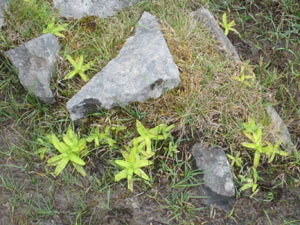|
|
Marvels of Nature
Although Herbert’s Quarry is not yet recognised
for the importance of its industrial remains, the site is part of the Mynydd Du Site of Special
Scientific Interest (SSSI). This status reflects its national importance for its geology, land
forms, vegetation and wildlife. But what makes the site extra special is that without the industrial remains, much of the wildlife that makes the place important would not be here at all!
|
|
|

|
The limestone environment supports a variety of unusual plants that
are adapted to the environment, such as these insectivorous Butterworts.
Other interesting plants that like the wet and alkaline environment include mosses, ferns and fungi such as waxcaps and earth-tongues. Herbert’s Quarry is also a Regionally Important Geological Site (RIGS), home to a rare and enigmatic mineral formation known as ‘Tufa’. |
| Tufa

|
On a very wet day during our survey work, we were visited by Louis Emery from Cardiff University . He introduced us to the fascinating world of 'Tufa', a curious phenomenon that occurs at the Black Mountain Quarries! |
|
Tufa is normally only found in underground cave systems (such as at the Dan yr Ogof caves). Because of a unique set of conditions, at Herbert's Quarry tufa has formed above ground! As water rises from below ground it washes through the spoil tips left over from making lime, and absorbs calcium hydroxide (Ca(OH)2) . This makes the water very alkaline (as much as Ph12!). As it reaches the surface the alkaline water reacts with Carbon dioxide from the air and the calcium hydroxide turns into solid calcium carbonate (CaCO3) also called Calcite. |
|
Tufa does not normally form in this way. Normally, the alkaline waters release CO2 when they reach the surface. This increases the alkalinity, but reduces the solubility of the carbonate which therefore 'crystalises'.
As this process has continued over the centuries, the calcium carbonate has created a variety of beautiful mineral formations. |
|
|
|
|
